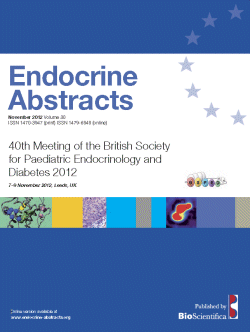Searchable abstracts of presentations at key conferences in endocrinology

40th Meeting of the British Society for Paediatric Endocrinology and Diabetes
Speaker Abstracts
CME TRAINING DAY
ea0030s1 | CME TRAINING DAY | BSPED2012
Physiology and developmental disorders of the pituitary
The pituitary gland is a central regulator of growth, homeostasis and reproduction. It is in turn regulated by the hypothalamus, which generates a number of releasing factors (GHRH, TRH, GnRH, CRH) and the inhibitory hormone somatostatin. The pituitary gland consists of the anterior and posterior lobes, both of which have separate developmental origins. The anterior lobe derives from the oral ectoderm, whilst the posterior lobe derives from the neuroectoderm. The anterior pitu...
ea0030s2 | CME TRAINING DAY | BSPED2012
Causes, diagnosis and management of pituitary dysfunction
Only small advances were made in the field of pituitary imaging until the advent of magnetic resonance imaging (MRI), which led to an enormous increase in our detailed knowledge of pituitary morphology, thus improving the differential diagnosis of hypopituitarism. Indeed, MRI represents the examination method of choice for evaluating hypothalamicpituitary-related endocrine diseases thanks to its ability to provide strongly-contrasted high-resolution multi-planar and spat...
ea0030s3 | CME TRAINING DAY | BSPED2012
The surgical management of pituitary tumours
In the UK, ~1000 new patients are diagnosed with a pituitary tumour every year and 4.2% of all paediatric tumours are craniopharyngiomas. Although these tumours are predominantly benign, untreated they can lead to visual compromise, raised intracranial pressure and the endocrine effects of hypersecretion or hypopituitarism, resulting in significant morbidity and mortality. This talk provides an overview of the presentation and management of pituitary tumours and craniopharyngi...
ea0030s4 | CME TRAINING DAY | BSPED2012
Genetic disorders of thyroid physiology and development
Congenital Hypothyroidism (CH) is the commonest inborn endocrine disorder (prevalence 1 in 3000), and occurs either due to failure of normal gland development (thyroid dysgenesis), or due to defective thyroid hormone synthesis in a structurally normal gland (dyshormonogenesis). Mutations in known thyroid transcription factors, and in genes encoding components of the thyroid hormone biosynthetic machinery, have been implicated in CH, attesting to the role of these genes in huma...
ea0030s5 | CME TRAINING DAY | BSPED2012
Hypothyroidism
Hypothyroidism exists when function of the hypothalamicpituitarythyroid axis is impaired, either with normal or subnormal thyroid hormone levels compensated and decompensated hypothyroidism. Hypothyroidism is called primary when the abnormality is at the level of the thyroid gland itself and central when the defect is in the hypothalamo-pituituary axis.Central hypothyroidism, whether congenital or acquired, almost always occurs in the ...
ea0030s6 | CME TRAINING DAY | BSPED2012
Hyperthyroidism and its management
Thyrotoxicosis is uncommon in young people with a UK incidence around 1/100 000 (<15 years). Most cases of persistent thyroid hormone excess are due to Graves disease although transient episodes are seen in Hashimotos thyroiditis. Thyroid peroxidase antibodies can frequently be identified in both forms of autoimmune thyroid disease with antibodies to the TSH receptor more typical of Graves. Patients with Graves are usually managed initially with the...



